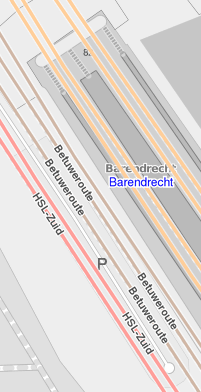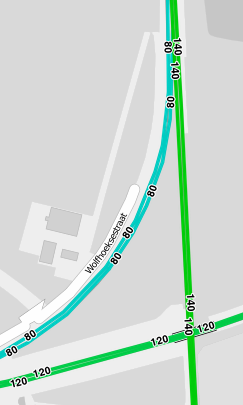NL:OpenRailwayMap
OpenRailwayMap (het voormalige "Bahnkarte") is een gedetailleerde online kaart van de wereldwijde spoorinfrastructuur, gebaseerd op de data van OpenStreetMap. Sinds halverwege 2013 beschikbaar via openrailwaymap.org. (deze Nederlandse pagina wordt nog verder vertaald vanuit het Engels)
Omschrijving
Het ORM-project is van start gegaan in December 2011 om een wereldwijde, vrij te gebruiken, actuele en gedetailleerde kaart van de railinfrastructuur, gebaseerd op OpenStreetMap. Het domein werd geregistreerd op 27 april 2013 en de corresponderende website werd halverwege 2013 gelanceerd. Sindsdien is de kaart constant verbeterd. In februari 2014 verhuisde het project naar een nieuwe server. In april 2014 werd een mobiele versie gelanceerd.
OpenRailwayMap beslaat alle spoor-infrastructuur; hierbij hebben we het over infrastructuur met twee spoorstaven per spoor. Hieronder vallen bijvoorbeeld klassiek spoor, metro's, trams, miniatuurspoor en bergspoor. De kaart bevat geen kabelbanen, monorails en magneetzweefbanen.
De naam OpenRailwayMap refereert vooral naar de online kaart, maar het project streeft er ook naar om de rail-infradata van OpenStreetMap te verbeteren. Dit door de ontwikkeling van een consistent data model, het voorzien in een mailinglijst voor discussie, het ontwikkelen van editor plugins, etc. Het verkrijgen van deze data wordt gestimuleerd en de data wordt bruikbaar gemaakt voor andere applicaties en ontwikkelaars.
Aanleiding
OpenRailwayMap heeft als doel om een spoorwegkaart van een nieuwe kwaliteit te bieden en biedt de volgende voordelen:
- Wereldwijde dekking: Tot nu toe is er nog geen spoorwegkaart die de hele wereld beslaat. Er bestaan vooral kaarten voor enkele landen.
- Open source en open data: Op dit moment bestaan er vrijwel geen spoorwegkaarten die, behalve gerenderde kaarten, ook originele geodata aanbieden. Vrijwel alle huidige kaarten bieden deze data niet aan onder een open licentie. Dit project is gebaseerd op OpenStreetMap data welke is gepubliceerd onder de Open Database License.
- Actueel en gedetailleerd: Deze kaart heeft als doel om de vruchten te plukken van zogenaamde crowdsourcing. Dat houdt in dat veel mensen van over de hele wereld met goede lokale kennis deze kaart kunnen bewerken om het gedetailleerd te maken en actueel te houden.
- OpenStreetMap: Er zijn al vele kaarten gebaseerd op de data van OpenStreetMap; bijvoorbeeld scheepskaarten, fietskaarten, hike-kaarten, autokaarten, kaarten van energie infrastructuur en nog vele andere. Echter was er nog geen OpenStreetMap kaart speciaal voor het spoor.
Use cases
There are several good reasons for creating an open, comprehensive railway map of the world. Just some just cases:
- Simulation: Detailed railroad data is an excellent source for simulating trains and signal boxes realisticly.
- Research: Scientists and researchers can use the data to analyse the railroad network, simulate changes and use it for educational purposes.
- Plans for model trains: This detailed railroad data is a good data source for railway enthusiasts, who want to build a railroad line as a model. With this data you do not need to record the railroad tracks anymore.
- Enthusiasts: There are many people interested in railways, e.g. trainspotters. For those people this map provides a detailed information source of the railroad network.
- Basemap for realtime traffic: Other applications can use this map to track the position of trains or to provide a realtime view of the trains' current position. You can also think of applications showing construction sites, detours, blockings and the traffic density.
- Routing: With a detailed mapped railway infrastructure you could develop a routing application.
- Public transport: This map and the data are an important data source for public transport applications like timetables, routing, ... .
Mapping
For the average mapper mapping the railroad network is a bit more complicated than mapping streets or POIs, but there are some suitable ways of mapping:
- Aerial imagery: Railroad tracks can easily be drawn based on aerial imagery, if high-resolution images are available for your area. With those imagery you can map even great yards simply from home. If you have access to very good high-resolution imagery (e.g. Aerowest), you can also see platforms or even signals.
- In trains: In areas without high-resolution aerial imagery you can track the railroad lines with the GPS while sitting in the train. You should give attention to a sufficient GPS signal in the train to generate exact tracks (see WikiProject_Germany/Railway).
- Along the railroad lines: Especially in rural areas the railroad lines can be accessed easily from ways parallel to the tracks. From there you can map signals or milestones fast, easy and safe. Crossings and bridges are also a good possibility to have a look at a part of the railroad line.
- Stations: In stations you can map a lot of details without risk and easy to access.
- Other sources: Public data, data sources with usage permission, use pictures from trainspotters or videos from the driver's cab after getting their permission, ... A huge amount of free railway pictures is also available at Wikimedia Commons.
Note: In all ways of mapping, you have to respect some rules:
- Don't violate general laws: Don't enter railroad areas without permission, don't interrupt the railroad traffic, ... . Use just data you can get from public location (examples are mentioned some lines before)
- Don't put yourself at risk
- Don't use illegal, non-public, confidential or legally doubtful data sources
- Don't violate copyright laws and don't copy from other maps
For newbies: You can donate data, but do not know, how to get into OSM? You have interesting information you can share, but no time to do this yourself? Contact me and send me your data with a permission so that I can do this job of mapping for you.
Functies
- Three overlays based on numerous backgrounds (including hillshades)
- for infrastructure (including milestones, switches, track numbers, signal boxes)
- for signals
- for maximum track speeds
- Numerous search features, stations, milestones and level crossings
- Permalinks
- Dedicated version for mobile phones.
- Daily updates, starting at around 1:00 in the morning (Central European Time), taking about four hours.
- Multiple languages, including: Czech, Danish, Dutch, English, French, German, Greek, N'ko, Polish, Portugese, Russian, Slovenian, Spanish, Swedish, Ukrainian and Vietnamese. As much as 19 translations are available or underway (as of May 2014). Translations are coordinated via Transifex.
Enkele voorbeelden
There is still a long way to go for both the software and the underlying detailed data. However, there is are quite some examples that show where we are going:
- Neuss Hauptbahnhof. A mid-sized railway station in Germany, mapped in much detail.
- Bahnhof Wernigerode: a small station with many signals
- Dresden, Frankfurt, Nuremberg and Stuttgart are some already quite well mapped large-scale railway hubs.
Tagging
For mappers it is recommended to ignore the complex tagging scheme and to use the JOSM presets made for single countries. The presets simplify the complex and general tagging and makes it easy to use without learning tags.
Country-specific tagging
Er zijn lijsten van belangrijke objecten in verschillende landen met voorbeelden van hoe om deze te taggen. Iedereen kan een land toe te voegen of voorbeelden toevoegen aan een bestaand land.
On these pages you can find country-specific information about mapping signals or working rules correctly. There are also some illustrated practical tagging examples. Everybody is invited to add more countries or add some examples for an existing country.
- Australië
- België
- Duitsland
- Nederland
- Oostenrijk
- Noord Amerika (Verenigde Staten, Canada, en Mexico)
- Verenigd Koninkrijk
JOSM voorinstellingen
For easier mapping you can use the JOSM preset files.
So far, one dedicated JOSM preset has been created. It is aimed at German railway lines and available in the preset directory. There is more information on JOSM tagging presets at the JOSM Tagging presets Wiki page.
Any further presets are very much appreciated. See Contribute.
Gerelateerde tagging-proposals
- Proposed_features/Railway
- Proposed_features/Railway_Signals
- Proposed_features/detailed_Railway_Network
Bijdragers
- rurseekatze (founder, developer, administrator)
- bigbug21 (documentation, JOSM presets)
- Nakaner (icons)
- Margin-auto
- Rohieb (JOSM-Presets)
Download
The latest development version is available for Download. A changelog is available in the Github repository
Gebruikte software
- Leaflet
- Kothic JS
- NodeJS
- node-tileserver
- osmfilter
- osmconvert
- osmupdate
- osm2pgsql
- PostgreSQL
- PostGIS
- Linux, Apache, PHP, Javascript, ...
Tiles en API
To request certain data, you can use our API. There is also a possiblity to include the tiles into other applications. For more information about the terms of use and technical details, please read the API documentation.
Eigen ontwikkelingen
Everybody is allowed to use OpenRailwayMap as a base for own work, if this is compatible to the terms and conditions of the GNU General Public License Version 3. In exceptional cases I will also allow modified conditions!
Bugs / Nieuwe functies / Ideeën / TODO's
Bug reports and suggestions should be reported at the bugtracking system. Users without a Github account can also get in touch with the developer.
Contribute
Contributors are welcome to help as programmers, translators or designers. Please contact me if you want to contribute.
Mapping: The usability of this map depends on the data. Please use your knowledge to keep the mapped information up-to-date and insert more details!
Programming: You created an interesting new feature or fixed a bug in the existing code? Please send me your code and I will add it.
Translating: OpenRailwayMap wants to be available for many users and in many languages. Please translate the application, the preset files or this wiki page to other languages!
Design: The current design is not very good. Please help to improve it or improve the support in many browsers.
Ressources: OpenRailwayMap is currently just a project run in my free time, so needed resources like hardware or domains are limited. You are welcome to support me with these resources!
JOSM-Presets: Create JOSM presets and styles for different countries!
Examples: Add images to the tagging examples or create example pages for new countries!
'Bug reports, browsertests and feature suggestions are desired. Please contact me.
Donaties
This project is operated by the developers in their spare time and has no commercial goals. By making a donation you can show that you appreciate the voluntary work of the developers and can motivate them to continue the project in the future.
But any donation is not only a form of recognition, but also a financial contribution to the costs that are caused by server, domains, etc.. Only with enough donations the project can be provided without advertising and for free also in the future.
Donations can be made via Paypal and Flattr. On request, donations by bank transfer can be arranged.
Contact
To contact me, please use one of the following ways:
- Wiki-Message
- OSM-Message
- E-Mail to info@openrailwaymap.org
Mailing list en IRC
- openrailwaymap (en)(de) Mailing list for users and developers of OpenRailwayMap, but also other railway related stuff.
Register - Archive, NNTP gateway via Gmane - #OpenRailwayMap (en)(de) IRC channel for users and developers of OpenRailwayMap, but also other railway related stuff.
irc://irc.oftc.net #OpenRailwayMap or Webchat
Nieuws
Evenementen
- OpenRailwayMap meetup, 6. June 2014 in Dresden, Germany
- Mapping Weekend 2014, 11.-13. July 2014 in Cologne, Germany
- Project Meeting 2014, 24.-26. October 2014 in Bad Nauheim, Germany
Zie ook
- OpenRailwayMap Category
- ÖPNV-Karte: A map of lines running on rail and road networks
- OSM Inspector for railways
- ITO Railway Maps
- OSM Tchouchou, trains map, live update in France, Irland, Finland, Danemark
- Train route analysis based on OSM data




